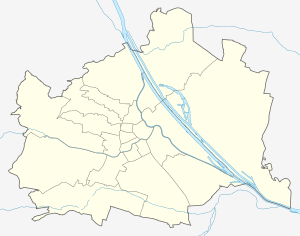Radetzky Bridge
Coordinates: 48 ° 12 ′ 41 ″ N , 16 ° 23 ′ 5 ″ E
| Radetzky Bridge | ||
|---|---|---|
| Radetzky Bridge over the Wien River at its confluence with the Danube Canal | ||
| use | Motor vehicles, trams, cyclists, pedestrians | |
| Crossing of | Vienna River | |
| place | Vienna , between the Inner City and Landstrasse , across the Wien River at its confluence with the Danube Canal | |
| construction | Iron bridge | |
| start of building | 1899 | |
| completion | 1900 | |
| location | ||
|
|
||
The Radetzkybrücke is a bridge over the Wien River and connects the two districts of Vienna Inner City and Landstrasse .
The Radetzky Bridge is the last bridge over the Wien River before it flows into the Danube Canal and connects Uraniastraße in the 1st district with Radetzkystraße in the 3rd district. Even before 1848 there was a wooden bridge at this point, which was torn away in 1851 by the flood that prevailed at the time. From 1854 to 1855 a stone arch bridge was built according to the plans of Johann Hermann Maack and in 1869 it was named "Radetzky Bridge ". From 1899 to 1900 the stone bridge was replaced by an iron bridge during the Vienna River regulation. The architectural design came from Josef Hackhofer and Friedrich Ohmann , based on whose designs the Kleine Marxerbrücke and the Vienna river barriers in the city park were created. Characteristic are the two arched girders with a stone river pillar and the decoration with Art Nouveau ornaments as well as the typical light rail railings by Otto Wagner . Between 1907 and 1908 two stone lighthouses were added. At the end of the war in 1945 it was badly damaged in the Battle of Vienna and it was not until 1952 that the reopening of the repaired bridge could be celebrated. From 1978 to 1979 it was renovated and rebuilt, and in 1991 the lighthouses that disappeared during the war were reconstructed using old photos.



